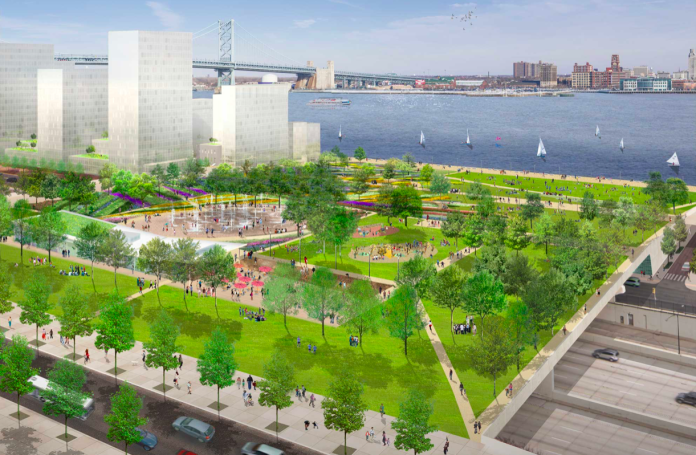A visit from a Philadelphia planner with expertise on freeway lids offers insights for how to reconnect Seattle.
Last week the Downtown Seattle Association (DSA) invited Karen Thompson, Director of Planning at the Delaware River Waterfront Corporation (DRWC), to participate in a panel discussion, From a Freeway to Future Possibilities: The Opportunity to Lid Interstate 5.
DRWC has led the charge to build a freeway lid, which they call a “cap,” over Interstate 95 (I-95) in central Philadelphia. The project, which secured full funding in 2017, is currently in its final design phase. The freeway cap will create a new public park, reconnecting the center city with historic Penn’s Landing on the Delaware river.
Other panelists included Sam Assefa, Director of the Office of Planning and Community Development (OPCD) and Liz Dunn, Principal, Dunn & Hobbes, LLC and a member of the Lid I-5 steering committee. The panel was moderated by Larry Costich, a real estate attorney with a background as a civil and environmental consulting engineer.
The panel discussion was held during the final breakout session of the DSA’s annual State of Downtown, which was themed, “Big Ideas, Big Challenges” and addressed topics related to creating a more vibrant and resilient downtown Seattle.
Philly’s New Freeway Cap
In 2012, Philadelphia City Planning Commission adopted a Master Plan for the Central Delaware Waterfront. Similar to Seattle’s situation with the Alaskan Way Viaduct, Philadelphia was cut off from its waterfront by the construction of I-95 in 1960’s.
However, the construction of I-95, which runs the entire length of Philadelphia, left a freeway scar more reminiscent of Seattle’s Interstate 5 (I-5) east-west divide.

As in Seattle, the expansion of freeways throughout Philadelphia was not without controversy. Despite early critics’ protests that the freeway would destroy historic neighborhoods and increase environmental degradation, the City of Philadelphia Planning Commission proceeded with plans to increase car infrastructure throughout the city .
“We think it better not to fight with the automobile…but rather to treat it as an honored guest and cater to its needs,” said City Planning Commission Executive Director Edmund Bacon. (Side note: “Ed” Bacon was not only Philadelphia’s most famous city planner, but also the father of actor Kevin Bacon–an easy win in six degrees of Kevin Bacon.)
Some of those community complaints came from the well-heeled Society Hill neighborhood, which did achieve modifications to the freeway design that resulted I-95 being capped in two short sections.
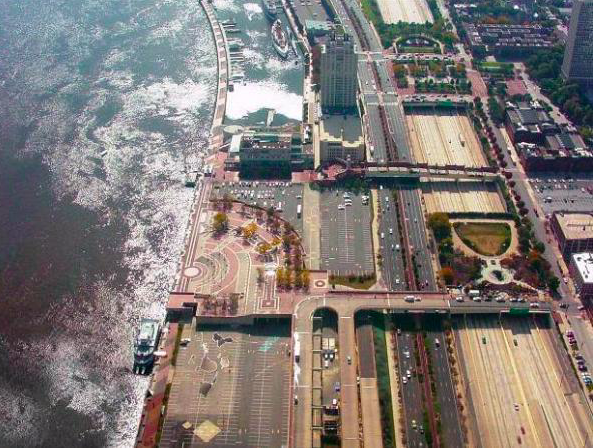
It also began a decades-long conversation about increasing the size of the freeway cap, which resulted the current plans for Penn’s Landing Park.
The total budget for Penn’s Landing Park is $225 million, and it has been paid for by a combination of public and philanthropic investment. The new freeway cap will be entirely dedicated to public open space and feature amenities and programming for the public to enjoy. In order to drum up enthusiasm for the coming park, DRWC has been activating existing Spruce Street Park with hammocks, floating gardens, a popular beer barge, and food from Philly restaurants. So far the results have exceeded expectations.
“We had a half million people come out in just the first two months of operations,” Karen Thompson said. “It was a huge success.”

The project is currently in its final design phase during which decisions are being made about layout of the public park, which will include green stormwater infrastructure to help filter runoff into the Delaware river.
The construction period for the project is estimated at three years. Because of the nature of the infrastructure’s design, impacts on the I-95 traffic during that period will be minimal.
DRWC is also responsible for a parcel of land adjacent to Penn’s Landing Park that has been earmarked for development. Current plans call for the construction of 1,500 new housing units, 500 hotel rooms, and more than 100,000 square feet of retail, restaurants, and entertainment. Land leases for these properties will contribute toward the park’s long term operations and management costs.
Lidding Freeways is a Nationwide Trend
Penn’s Landing Park is an example of a nationwide trend in which an increasing number of cities are seeking to heal their freeway scars with urban design solutions such as freeway caps or lids. Cities like Dallas have already implemented lids–Klyde Warren Park in its case. In a lot of cities, including Philadelphia, the construction of freeway lids has been framed as a way to “fix a problem from the past.”
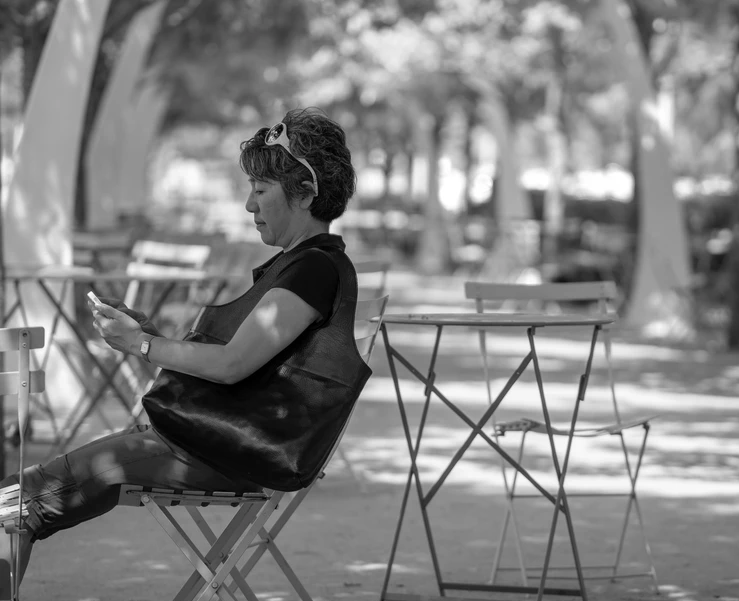
The same could be said of lidding I-5 in Seattle.
Similar to Philadelphia, Seattleites have been strategizing about how to mitigate the damage I-5 has inflicted on the city’s urban built environment for decades. Using freeway lids to create new public land and reconnect divided neighborhoods is not a new idea in either city; both have existing freeway lids that date back decades.
The idea to cover the freeway and create new land has gained greater relevance as development continues to increase in urban cores. While Penn’s Landing Park will not be the site of new residential or commercial buildings, it will enable the development of nearby land parcels while also increasing the livability of existing in neighborhoods.
In Seattle, the uses for a freeway lid remain to be determined, but could include space for affordable housing, schools, retail and commercial development, as well as other public amenities such as a park.
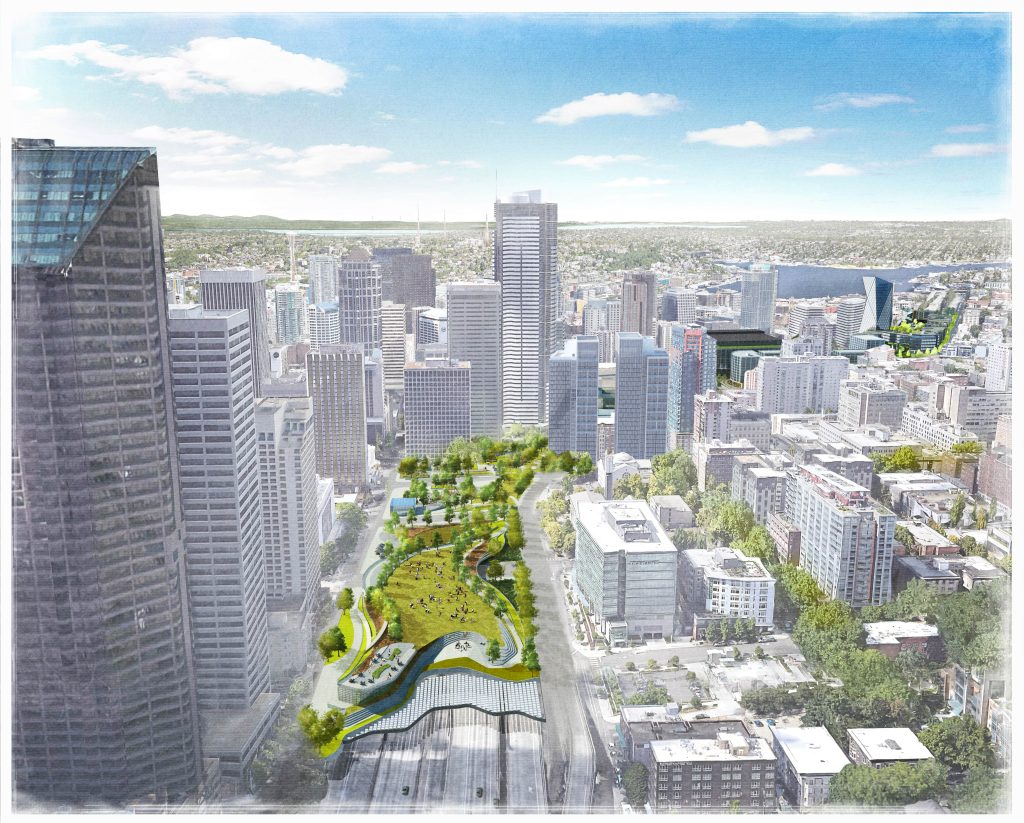
Key Takeaways for Seattle
Penn’s Landing Park offers a few important takeaways for freeway lid supporters in Seattle. The first is patience. The current iteration of a freeway cap at Penn’s Landing was first presented in 2011; now in 2019 it is nearing construction, but completion of the project is still years away. Advocates in Seattle need to accept that success of a freeway lid project will depend on persistence and a focus on long-term goals.
Additionally, it will be necessary to build a strong coalition of support. Penn’s Landing Park was able to succeed because a high level of public and political support backed the project and allowed it to advance forward despite challenges.
For example, after being presented with the freeway cap concept the Pennsylvania Department of Transportation (PennDOT), initially stated that it would be best for construction to wait until the 2040’s, when the Philadelphia corridor of I-95 is scheduled to be rebuilt. However, the agency quickly shifted its position after receiving the broad feedback that it would be unacceptable to wait that long. PennDOT then emerged as a powerful supporter and backer of the project.
In Seattle, the Washington State Department of Transportation (WSDOT) will be a critical ally for any future lid project. However, WSDOT has many responsibilities including maintenance, preservation, and eventual replacement of the entire aging I-5 corridor. Thus supporters of future lid projects will need to make sure that a focus on mitigating negative impact of the freeway is not lost as WSDOT undertakes other critical work.
Finally, Thompson was adamant about the importance of achieving small wins along the way. Activation of Spruce Street Park allowed for DRWC make the case for an enhanced waterfront in central Philadelphia. In Seattle, this might mean better activation of existing Freeway Park, which is constructed on a freeway lid over I-5. A well-used Freeway Park would create a compelling case for lidding more of the interstate.
As part of the Washington State Convention Center public benefit package Seattle Parks and Recreation was awarded $10 million to repair, restore and enhance Freeway Park. Dubbed “Finding Freeway Park,” the project includes both capitol improvements and increased public programming.
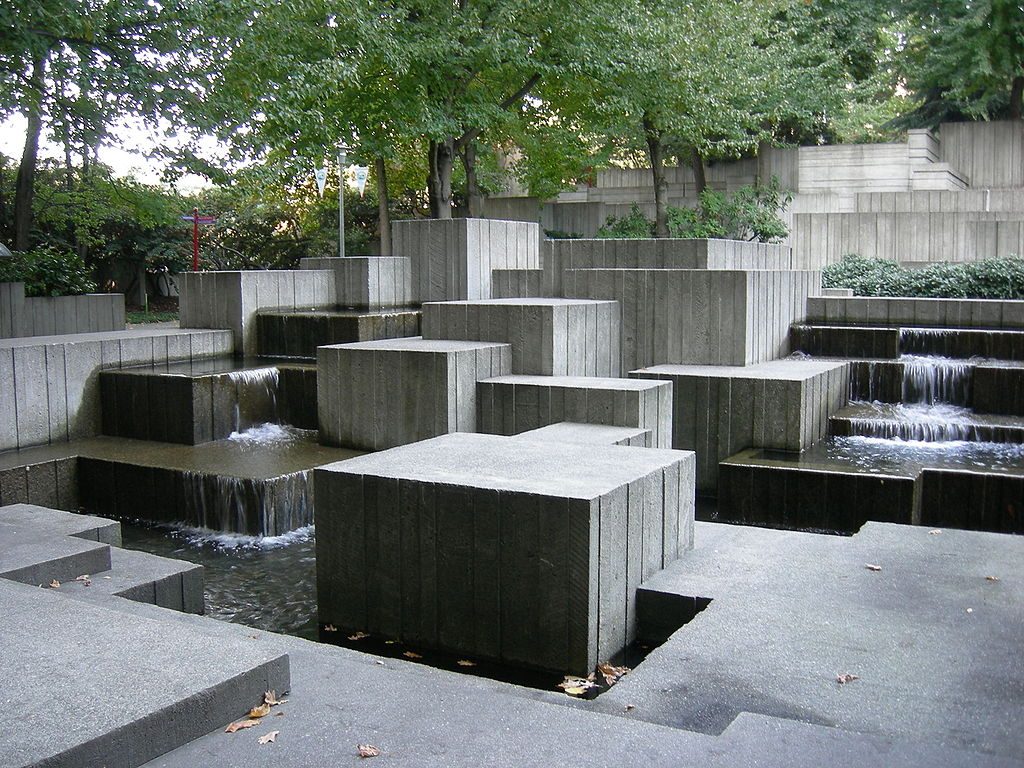
The convention center public benefit package also provided $1.5 million in funding for a Lid I-5 Feasibility Study. The City is currently in the process of selecting a firm to complete the feasibility study, which will focus on structural and economic data.
As the technical feasibility study moves forward, the Lid I-5 campaign will continue to assemble additional case studies of freeway lid projects across the U.S. The campaign intends to share these case studies with the public later this year.
Full disclosure: The author is a member of the Lid I-5 steering committee.
Natalie Bicknell Argerious (she/her) is a reporter and podcast host at The Urbanist. She previously served as managing editor. A passionate urban explorer since childhood, she loves learning how to make cities more inclusive, vibrant, and environmentally resilient. You can often find her wandering around Seattle's Central District and Capitol Hill with her dogs and cat. Email her at natalie [at] theurbanist [dot] org.


